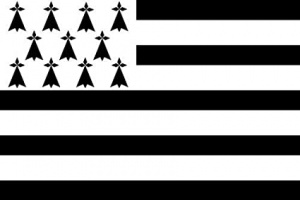Language/Breton/Grammar/Adjectives
Hi Breton learners! 😊
In this lesson, we will learn about adjectives in Breton grammar, and how to use them to describe objects and people!
Introduction[edit | edit source]
In Breton, adjectives play an important role in constructing sentences. They help to add descriptions and details to a sentence, and can be used to convey emotions and feelings. In this lesson, we will explore how to use adjectives in Breton, and how to modify them according to gender and number. We will also look at some common adjective examples in Breton. Let's get started!
With the completion of this lesson, consider investigating these related pages: Personal Pronouns, How to Use "Be", Plurals & Pronouns.
Gender, Number and Agreement[edit | edit source]
In Breton grammar, adjectives must agree in gender and number with the noun they modify. This means that if the noun is feminine, the adjective must also be feminine, and if the noun is plural, the adjective must also be plural. Let's take an example sentence:
- Bugel bihan (Little child)
Here, the adjective "bihan" means "little", and agrees in gender (masculine) and number (singular) with the noun "bugel" (child). If we were to modify the sentence to describe a little girl, we would say:
- Bugelig bihan (Little girl)
Here, the adjective "bihan" now agrees in gender (feminine) with the noun "bugelig" (girl).
To form plural adjectives in Breton, we usually add -ed at the end of the adjective:
- Dilhadioù glas (Blue clothes)
Here, the adjective "glas" (blue) agrees in gender (masculine) and number (plural) with the noun "dilhad" (clothes).
Comparison[edit | edit source]
In Breton, there are two types of comparison: the comparative and superlative. The comparative is used to compare two objects or people, while the superlative is used to describe one object or person as the most or least in a group. To form the comparative in Breton, we use the word "miz" (more):
- Muioc'h brav eo ar maez (The table is more beautiful)
Here, the adjective "brav" (beautiful) is modified to "maez" (more beautiful) to form the comparative.
To form the superlative in Breton, we use the word "mañez" (most):
- Ar re all a zo nemetoer, met ar re-mañ a zo ar bed (The others are just stars, but these are the world)
Here, the adjective "bed" (world) is modified to "ar re-mañ" (the most), to form the superlative.
Examples[edit | edit source]
Here are some common adjectives in Breton, along with their English translations and pronunciations:
| Breton | Pronunciation | English |
|---|---|---|
| beuzeg | beh-oo-zeg | old |
| bihan | bee-han | little |
| bras | bras | big |
| faltazi | fahl-tah-zee | bald |
| foñv | fon-v | deep |
| glas | glahs | blue |
| kaer | kay-er | beautiful |
| loen | lo-en | thin |
| mad | maht | good |
| melen | mel-en | yellow |
| meur | mehr | many |
| nevez | neh-vez | new |
| skañv | ska-ñv | rough |
| tap | tap | short |
| tomm | tomm | fat |
| trist | trist | sad |
| vras | vras | great |
Dialogue[edit | edit source]
Person 1: Me a ya da gavout ma c'hwec'h vamm en ur c'harr (I'm going to see my six aunts in a rowboat)
Person 2: Penaos eo an avel (How is the wind)?
Person 1: An avel n'eo ket gwall bev en dachenn ma mabig (The wind is not too strong in my nephew's area)
Person 2: Bez' eo! Mont a ra re vizkoazh ma vammet (Great! My mother is getting even older)
Person 1: Bez' eo, met kaer eo ha skañv eo (She is old, but beautiful and rough)
Conclusion[edit | edit source]
In Breton grammar, adjectives play an important role in describing objects and people. They must agree with the noun they modify in gender and number, and can be used to form comparatives and superlatives. By using adjectives effectively, you can add emotion and detail to your Breton sentences. To further improve your Breton grammar, you can use the Polyglot Club website. Find native speakers and ask them any questions!
➡ If you have any questions, please ask them in the comments section below.
➡ Feel free to edit this wiki page if you think it can be improved. 😎
Well done on mastering this lesson! Don't miss these related pages to expand your knowledge: Gender, Negation, Give your Opinion & How to Use Have.
Other Lessons[edit | edit source]
- Plurals
- Conditional Mood
- Give your Opinion
- How to Use Be
- Questions
- Negation
- How to Use Have
- Future Tense
- Personal Pronouns
Sources[edit | edit source]

